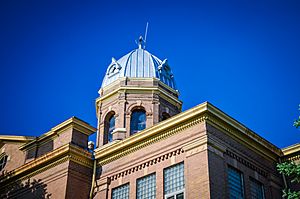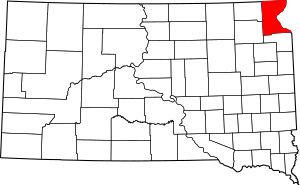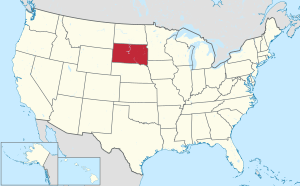Roberts County, South Dakota facts for kids
Quick facts for kids
Roberts County
|
|
|---|---|

Roberts County Courthouse
|
|

Location within the U.S. state of South Dakota
|
|
 South Dakota's location within the U.S. |
|
| Country | |
| State | |
| Founded | March 8, 1883 (organized) August 6, 1883 (organized) |
| Named for | S. G. Roberts |
| Seat | Sisseton |
| Largest city | Sisseton |
| Area | |
| • Total | 1,136 sq mi (2,940 km2) |
| • Land | 1,101 sq mi (2,850 km2) |
| • Water | 35 sq mi (90 km2) 3.1% |
| Population
(2020)
|
|
| • Total | 10,280 |
| • Estimate
(2023)
|
10,206 |
| • Density | 9.049/sq mi (3.494/km2) |
| Time zone | UTC−6 (Central) |
| • Summer (DST) | UTC−5 (CDT) |
| Congressional district | At-large |
Roberts County is a county located in the northeastern part of South Dakota, a state in the United States. In 2020, about 10,280 people lived here. The main town and county seat is Sisseton.
The county got its name from either S. G. Roberts, who was from Fargo, North Dakota, or Solomon Robar, an early French fur trader in the area. Roberts County was officially created on March 8, 1883. It was fully set up by August 6 of the same year. Its borders were changed once in 1885.
Contents
Geography
Roberts County is in the very northeast corner of South Dakota. Its eastern side touches Minnesota across the Bois de Sioux River. Its northern side borders North Dakota. The Cottonwood Slough is a waterway that flows south. It drains the northern part of the county into the river.
The land here has rolling hills, which are mostly used for farming. The land slopes down towards the east. The highest point is on its western border. It is about 2,047 feet (624 meters) above sea level.
Roberts County covers about 1,136 square miles (2,942 square kilometers). Most of this, about 1,101 square miles (2,852 square kilometers), is land. The rest, about 35 square miles (91 square kilometers), is water. The Traverse Gap is in the eastern part of Roberts County. It is right along the Minnesota border. Most of the county is part of the Lake Traverse Indian Reservation.
Main Roads
 Interstate 29
Interstate 29 U.S. Route 12
U.S. Route 12 U.S. Route 81
U.S. Route 81 South Dakota Highway 10
South Dakota Highway 10 South Dakota Highway 15
South Dakota Highway 15 South Dakota Highway 25
South Dakota Highway 25 South Dakota Highway 106
South Dakota Highway 106 South Dakota Highway 109
South Dakota Highway 109 South Dakota Highway 123
South Dakota Highway 123 South Dakota Highway 127
South Dakota Highway 127
Public Transport
- Jefferson Lines is a bus service that runs through the area.
Neighboring Counties
- Richland County, North Dakota - to the north
- Traverse County, Minnesota - to the northeast
- Big Stone County, Minnesota - to the southeast
- Grant County - to the south
- Day County - to the southwest
- Marshall County - to the west
Protected Natural Areas
- Big Stone Island State Nature Area
- Crawford State Game Production Area
- Knutson State Game Production Area
- Harmon State Game Production Area
- Hartford Beach State Park
- Peever Slough State Game Production Area
- Sica Hollow State Park (part of it)
- White Rock State Game Production Area
Lakes and Rivers
- Big Stone Lake
- Bois de Sioux River
- Clubhouse Lake
- Cottonwood Lake
- Dobberstien Slough
- Drywood Lakes
- Hurricane Lake
- Lake Bdesska
- Lake Traverse
- Little Minnesota River
- Oneroad Lake
- Owl Lake
- Round Lake
- Whetstone River (North fork)
- Whitestone Lake
Population Information
| Historical population | |||
|---|---|---|---|
| Census | Pop. | %± | |
| 1890 | 1,997 | — | |
| 1900 | 12,216 | 511.7% | |
| 1910 | 14,897 | 21.9% | |
| 1920 | 16,514 | 10.9% | |
| 1930 | 15,782 | −4.4% | |
| 1940 | 15,887 | 0.7% | |
| 1950 | 14,929 | −6.0% | |
| 1960 | 13,190 | −11.6% | |
| 1970 | 11,678 | −11.5% | |
| 1980 | 10,911 | −6.6% | |
| 1990 | 9,914 | −9.1% | |
| 2000 | 10,016 | 1.0% | |
| 2010 | 10,149 | 1.3% | |
| 2020 | 10,280 | 1.3% | |
| 2023 (est.) | 10,206 | 0.6% | |
| U.S. Decennial Census 1790-1960 1900-1990 1990-2000 2010-2020 |
|||
2020 Population Count
In 2020, the census showed 10,280 people living in Roberts County. There were 3,844 households and 2,568 families. This means there were about 9.3 people per square mile. There were also 4,788 homes available.
2010 Population Count
The 2010 census counted 10,149 people. There were 3,823 households and 2,655 families. The population density was about 9.2 people per square mile. There were 4,905 housing units.
Most people in the county were white (61.7%). About 34.5% were Native American. A small number were Asian (0.2%) or Black (0.1%). About 1.2% of the population was of Hispanic or Latino background. Many people had German (31.3%) or Norwegian (19.2%) family roots.
In 34.4% of homes, there were children under 18. About 49.1% of homes had married couples. The average household had 2.58 people. The average family had 3.11 people. The average age of people in the county was 39.5 years old.
The average income for a household was $37,708. For a family, it was $46,146. About 20.0% of all people lived below the poverty line. This included 33.9% of children under 18.
Towns and Villages
Cities
Towns
Census-Designated Places
These are areas that are like towns but not officially organized as cities or towns.
- Agency Village
- Long Hollow
- Peever Flats
- White Rock Colony
Unincorporated Communities
These are small settlements without their own local government.
Townships
Townships are smaller areas within a county, often used for local administration.
- Agency
- Alto
- Becker
- Bossko
- Bryant
- Dry Wood Lake
- Easter
- Enterprise
- Garfield
- Geneseo
- Goodwill
- Grant
- Harmon
- Hart
- Lake
- Lawrence
- Lee
- Lien
- Lockwood
- Long Hollow
- Minnesota
- Norway
- One Road
- Rosholt
- Ortley
- Sisseton
- Springdale
- Spring Grove
- Summit
- Victor
- White Rock
Famous People
- Sleepy Eye, a chief of the Sisseton Sioux people.
- Gene Okerlund, a well-known wrestling announcer.
Schools
Here are the school districts in Roberts County:
- Big Stone City School District 25-1
- Milbank School District 25-4
- Rosholt School District 54-4
- Sisseton School District 54-2
- Summit School District 54-6
- Waubay School District 18-3
- Wilmot School District 54-7
See also
 In Spanish: Condado de Roberts (Dakota del Sur) para niños
In Spanish: Condado de Roberts (Dakota del Sur) para niños

